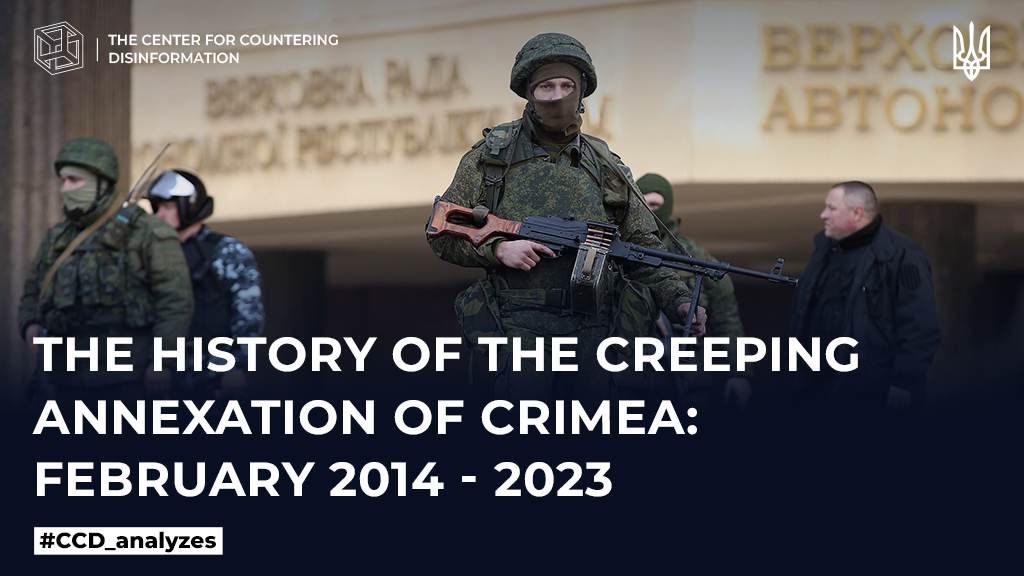The first signs of the beginning of the special operation for the annexation of Crimea by russia were observed as early as January 20, 2014. It was then that trucks without license plates and russian soldiers with weapons but without identification marks appeared on the peninsula, who were called “little green men”. At the same time, formations of russian Cossacks were created under the “cover” of local self-defense units. The situation in Crimea is becoming increasingly unstable.
In February 2014, the most dramatic stage in the modern history of Crimea begins.
On February 20, 2014, against the background of the tragic events in the center of Kyiv, the kremlin’s long-planned special operation to occupy the Crimean peninsula began. In Sevastopol and Simferopol, the special services organized anti-Ukrainian rallies under separatist slogans and St. George’s ribbons, in which the leading role of “indignant Crimeans” was played by specially imported russian citizens from among athletes, employees of security firms, and former military personnel who provoked conflicts and tried in every possible way to destabilize the situation.
On the night of February 21-22, when Yanukovych left the country, anti-Ukrainian protests in Crimea erupted with new force. Employees of the main offices of the Ministry of Internal Affairs of Ukraine and Security Service of Ukraine in Crimea and the offices of the Ministry of Internal Affairs of Ukraine and Security Service of Ukraine in Sevastopol immediately began to sabotage orders from Kyiv after the escape of yanukovych.
On February 22, the entire management system of the Southern Military District of the armed forces of the russian federation was transferred to full combat readiness.
On February 23, the active phase of the military operation began in Sevastopol. A rally of 20,000 pro-russian forces took place on the city’s main square, where a russian citizen, businessman o.chalyi, was “elected” as the new head of the city state administration of Sevastopol, a decision was made not to pay taxes to Kyiv, and the creation of “Crimea self-defense” was announced. On the same day, troops of the Black Sea Fleet deployed anti-tank hedgehogs at the entrances to the city, and military equipment and terrorist units of the russian army began to be withdrawn en masse to the peninsula.
On February 24-25, the squadron of the Black Sea Fleet delivered to Sevastopol units of special forces of airborne troops and marines from Novorossiysk and a unit of special forces of the Main Intelligence Directorate from Ulyanovsk.
On February 26, a rally of several thousand Crimean Tatars and pro-Ukrainian activists in support of the territorial integrity of Ukraine took place in Simferopol. In contrast to this rally, the special services of the russian federation organized a rally of “russian unity”, which was led by a henchman of the russian occupiers, s.aksyonov. Up to 6,000 fighters of the Kuban Cossack Army, each of whom received 1,000 rubles per day for staying in Crimea, provided force support for the “protest actions”.
On the morning of February 27, 2014, “unknown” armed men in uniforms without identification marks seized the buildings of the Verkhovna Rada and the Government of the Autonomous Republic of Crimea and hung russian flags on them. As it was established later, this operation was carried out by servicemen of the 45th special regiment of the russian airborne forces from the Western Military District. At the same time, the Simferopol airport, the Kerch ferry crossing and other strategic objects were captured by the russian military, as well as the actions of the Ukrainian troops were blocked. At the same time, the Verkhovna Rada of Crimea, at the request of the invaders, announced the holding of a “referendum” on the peninsula on joining the russian federation.
On February 28, the exit from the Balaklava Bay was blocked by the Ivanovets missile boat, and the location of the military unit of the maritime border guards of Ukraine in Balaklava was surrounded by special forces of the russian federation.
From March 1 to 16, the main military facilities and administrative buildings of Crimea were captured by the russian military and paramilitary formations of the “Crimean self-defense”, and the number of russian military personnel increased to 20 thousand servicemen. At the same time, individual units of the Armed Forces of Ukraine steadfastly maintained their defense and left the peninsula only after receiving the relevant order on March 24, 2014.
On March 16, a “referendum” was held on the territory of Crimea and Sevastopol on the restoration of the Crimean constitution of 1992 and on the “inclusion” of Crimea into russia, which is not recognized by most countries of the world due to non-compliance with any generally recognized standards of popular expression.
On March 18, putin announced the “joining” of Crimea to russia. Western countries recognized the occupation and annexation of Crimea as illegal and imposed economic sanctions.
❗️ Summarizing the Crimean events of February-March 2014, it can be stated that the operation to capture the peninsula began long before that and became an unprecedented event for the post-war world order. The result of the annexation was the illegal persecution, imprisonment, repression of Ukrainians and Crimean Tatars and the formation of a russian military base, which provoked the formation of a liberation movement both in Crimea and in other temporarily occupied Ukrainian territories.
A full-scale russian invasion was 8 years ago…










